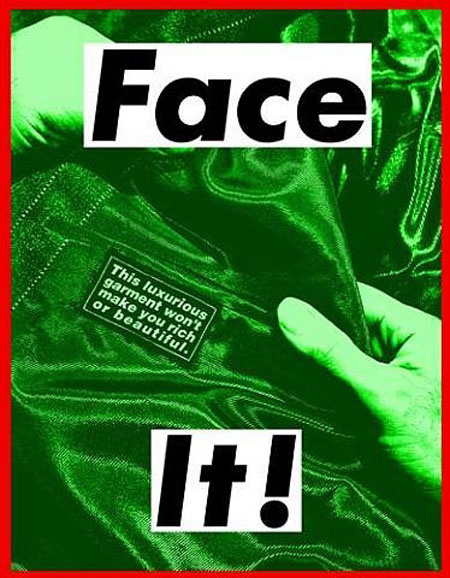Contemporary art exhibitions often display installations that have a specific semantic context and are designed to influence the public. The works of Barbara Kruger, as one of the prominent figures of visual art in recent years, contain unique messages and are widely known for their slogans. As an object of review, her print called “Face It (Green)” will be considered (Figure 1). This artwork emphasizes how meaningless the pursuit of expensive brands is when real wealth and beauty are in other values. The exhibitions that the Hirshhorn Museum and Sculpture Garden holds aim to attract the attention of the audience to pressing issues, and the features of the artwork in question reflect Kruger’s creative personality.

Physical Nature of the Artwork
Barbara Krueger, who is known for her provocative artworks, created the poster in question in order to draw attention to social stereotypes. According to Chen (2019), the artist used cultural phenomena as tools to make her works and focused on symbolism to reflect her vision of the world. The work under consideration is a pigment print with a size of 42.9 by 33 inches. As a material, a photo rag is applied, which, however, does not make the canvas less valuable. The presentation of the artwork is free, and anyone can see and appreciate Kruger’s idea of the futility of imitation and following stereotypes.
Content of the Artwork
The content of the artwork includes not only graphic but also textual elements. According to the representatives of the Hirshhorn Museum and Sculpture Garden, in recent decades, Barbara Kruger has focused on language messages and acted on the audience with special slogans (“Meet the artist,” 2012). This artwork depicts clothes with a label that warns the buyer that this wardrobe item will not make him or her either rich or beautiful. For an additional impact, the inscription “Face It!” is used as the irony that conveys the author’s attitude to prevailing trends. This approach is typical of Kruger’s art in recent years and serves as a means of ridiculing false values promoted in modern society.
In its physical expression, the print in question corresponds with the traditions chosen by Kruger. The bright inscription attracts viewers’ attention and serves as a visiting card of the artist. The green tint of the image is a stylization that makes it possible to focus on the promise of artwork rather than its design features. On the canvas, minimum details are presented, and the key emphasis is on the inscription on the garment, which carries the main meaning.
The catchy slogan “Face It!” reflects the position of the author and acts as her personal assessment of the content. Despite its minimalistic character, this print is recognizable all over the world due to a unique style to which Krueger adheres. The museum presentation of the artwork does not offer any additional design elements, although an exhibition setting itself draws attention to the canvas and makes one examine it carefully. These features of the artwork content distinguish it from many other contemporary artists’ installations.
Personal Response to the Artwork
When analyzing the presented artwork from an individual position, I can note the uniqueness of this print and its dissimilarity to many modern works. Kruger’s creativity is interesting due to her non-standard ideas and provocative appeals to the audience, which gives rise to curiosity and encourages reflection. I find this artwork unusual and, at the same time, exemplary in the context of public exposure. The ability to raise a problem and describe it in a few words characterizes this print as a valuable message to people. Therefore, I consider that it deserves mass attention and recognition.
When I drew attention to this artwork for the first time, I did not notice its significant difference from other Kruger’s prints. However, when studying the exhibition installation, I realize how different it is from those presented in art magazines and on specialized Internet portals. The absence of a person on the print, with the exception of two hands, seems to separate society and things and hints that one can make a conclusion even without additional emotions and appeals. Finally, the slogan “Face It!” is memorable, which was also an unexpected discovery for me. In general, this artwork has influenced my perception of contemporary art significantly due to its simplicity and, at the same time, deep and acute implication.
Conclusion
The considered Kruger’s print exhibited at the Hirshhorn Museum and Sculpture Garden is a unique artwork that reflects the acute social problem of a stereotypical approach to values. The symbolism used by the author serves as a successful technique, which makes it possible to delve into the proposed idea. This artwork has influenced me significantly and allowed me to look at contemporary art from a different angle.
References
Chen, Y. J. (2019). Control hegemony and subject self in Barbara Kruger’s works with pictures and words. EurAmerica, 49(3), 415-456.
Kruger, B. (2007). Face it (green). Web.
Meet the artist: Barbara Kruger. (2012). The Hirshhorn Museum and Sculpture Garden. Web.